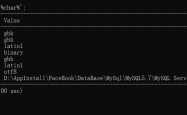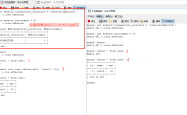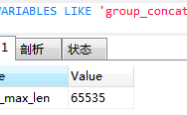mysql数据存储过程参数实例详解
MySQL 存储过程参数有三种类型:in、out、inout。它们各有什么作用和特点呢?
一、MySQL 存储过程参数(in)
MySQL 存储过程 “in” 参数:跟 C 语言的函数参数的值传递类似, MySQL 存储过程内部可能会修改此参数,但对 in 类型参数的修改,对调用者(caller)来说是不可见的(not visible)。
?| 1 2 3 4 5 6 7 8 9 10 11 | drop procedure if exists pr_param_in; create procedure pr_param_in ( in id int -- in 类型的 MySQL 存储过程参数 ) begin if (id is not null ) then set id = id + 1; end if; select id as id_inner; end ; |
| 1 2 3 | set @id = 10; call pr_param_in(@id); select @id as id_out; |
| 1 2 3 4 5 6 7 8 9 10 11 12 13 | mysql> call pr_param_in(@id); + ----------+ | id_inner | + ----------+ | 11 | + ----------+ mysql> select @id as id_out; + --------+ | id_out | + --------+ | 10 | + --------+ |
可以看到:用户变量 @id 传入值为 10,执行存储过程后,在过程内部值为:11(id_inner),但外部变量值依旧为:10(id_out)。
二、MySQL 存储过程参数(out)
MySQL 存储过程 “out” 参数:从存储过程内部传值给调用者。在存储过程内部,该参数初始值为 null,无论调用者是否给存储过程参数设置值。
?| 1 2 3 4 5 6 7 8 9 10 11 12 13 14 15 | drop procedure if exists pr_param_out; create procedure pr_param_out ( out id int ) begin select id as id_inner_1; -- id 初始值为 null if (id is not null ) then set id = id + 1; select id as id_inner_2; else select 1 into id; end if; select id as id_inner_3; end ; |
| 1 2 3 | set @id = 10; call pr_param_out(@id); select @id as id_out; |
| 1 2 3 4 5 6 7 8 9 10 11 12 13 14 15 16 17 18 19 20 21 | mysql> set @id = 10; mysql> mysql> call pr_param_out(@id); + ------------+ | id_inner_1 | + ------------+ | NULL | + ------------+ + ------------+ | id_inner_3 | + ------------+ | 1 | + ------------+ mysql> select @id as id_out; + --------+ | id_out | + --------+ | 1 | + --------+ |
可以看出,虽然我们设置了用户定义变量 @id 为 10,传递 @id 给存储过程后,在存储过程内部,id 的初始值总是 null(id_inner_1)。最后 id 值(id_out = 1)传回给调用者。
三、MySQL 存储过程参数(inout)
MySQL 存储过程 inout 参数跟 out 类似,都可以从存储过程内部传值给调用者。不同的是:调用者还可以通过 inout 参数传递值给存储过程。
?| 1 2 3 4 5 6 7 8 9 10 11 12 13 14 15 | drop procedure if exists pr_param_inout; create procedure pr_param_inout ( inout id int ) begin select id as id_inner_1; -- id 值为调用者传进来的值 if (id is not null ) then set id = id + 1; select id as id_inner_2; else select 1 into id; end if; select id as id_inner_3; end ; |
| 1 2 3 | set @id = 10; call pr_param_inout(@id); select @id as id_out; |
| 1 2 3 4 5 6 7 8 9 10 11 12 13 14 15 16 17 18 19 20 21 22 23 24 25 26 27 28 | mysql> set @id = 10; mysql> mysql> call pr_param_inout(@id); + ------------+ | id_inner_1 | + ------------+ | 10 | + ------------+ + ------------+ | id_inner_2 | + ------------+ | 11 | + ------------+ + ------------+ | id_inner_3 | + ------------+ | 11 | + ------------+ mysql> mysql> select @id as id_out; + --------+ | id_out | + --------+ | 11 | + --------+ |
从结果可以看出:我们把 @id(10),传给存储过程后,存储过程最后又把计算结果值 11(id_inner_3)传回给调用者。 MySQL 存储过程 inout 参数的行为跟 C 语言函数中的引用传值类似。
通过以上例子:如果仅仅想把数据传给 MySQL 存储过程,那就使用“in” 类型参数;如果仅仅从 MySQL 存储过程返回值,那就使用“out” 类型参数;如果需要把数据传给 MySQL 存储过程,还要经过一些计算后再传回给我们,此时,要使用“inout” 类型参数。
总结
以上就是本文关于mysql数据存储过程参数实例详解的全部内容,希望对大家了解MySQL有所帮助。有什么问题可以随时留言,小编会及时回复大家的。感谢朋友们对本站的支持!
原文链接:http://www.blogjava.net/nonels/archive/2008/10/09/233324.html
1.本站遵循行业规范,任何转载的稿件都会明确标注作者和来源;2.本站的原创文章,请转载时务必注明文章作者和来源,不尊重原创的行为我们将追究责任;3.作者投稿可能会经我们编辑修改或补充。










